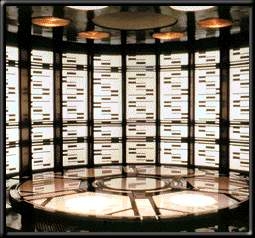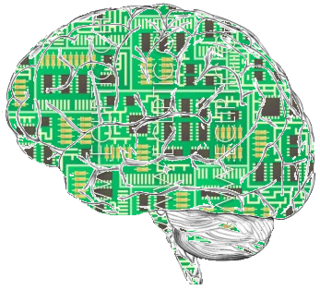Related Research Articles

A transporter is a fictional teleportation machine used in the Star Trek science fiction franchise. Transporters allow for teleportation by converting a person or object into an energy pattern, then sending ("beaming") it to a target location or else returning it to the transporter, where it is reconverted into matter ("rematerialization").

Derek Antony Parfit was a British philosopher who specialised in personal identity, rationality, and ethics. He is widely considered one of the most important and influential moral philosophers of the late 20th and early 21st centuries.
In metaphysics, identity is the relation each thing bears only to itself. The notion of identity gives rise to many philosophical problems, including the identity of indiscernibles, and questions about change and personal identity over time. It is important to distinguish between qualitative identity and numerical identity. For example, consider two children with identical bicycles engaged in a race while their mother is watching. The two children have the same bicycle in one sense and the same mother in another sense. This article is mainly concerned with numerical identity, which is the stricter notion.

Mind uploading is a speculative process of whole brain emulation in which a brain scan is used to completely emulate the mental state of the individual in a digital computer. The computer would then run a simulation of the brain's information processing, such that it would respond in essentially the same way as the original brain and experience having a sentient conscious mind.
The Ship of Theseus is a thought experiment about whether an object is the same object after having had all of its original components replaced.

Reasons and Persons is a 1984 book by the philosopher Derek Parfit, in which the author discusses ethics, rationality and personal identity.

The concept of uploading a mind into a computer, often into a simulated reality, is a recurring theme in science-fiction novels and films since the 1950s. Some stories describe societies of such minds.

I Am a Strange Loop is a 2007 book by Douglas Hofstadter, examining in depth the concept of a strange loop to explain the sense of "I". The concept of a strange loop was originally developed in his 1979 book Gödel, Escher, Bach.
In the end, we are self-perceiving, self-inventing, locked-in mirages that are little miracles of self-reference.
Average and total utilitarianism are variants of utilitarianism that seek to maximize the average or total amount of utility; following Henry Sidgwick's question, "Is it total or average happiness that we seek to make a maximum?". They are theories of population ethics, a philosophical field that deals with problems arising when our actions affect the number or identity of individuals born in the future.
Population ethics is the philosophical study of the ethical problems arising when our actions affect who is born and how many people are born in the future. An important area within population ethics is population axiology, which is "the study of the conditions under which one state of affairs is better than another, when the states of affairs in question may differ over the numbers and the identities of the persons who ever live."
Teleportation is a fictional transfer of matter or energy from one point to another without traversing the physical space between them. It is a common subject in science fiction literature and in other popular culture. Teleportation is often paired with time travel, being that the travelling between the two points takes an unknown period of time, sometimes being immediate. An apport is a similar phenomenon featured in parapsychology and spiritualism.
The philosophy of self examines the idea of the self at a conceptual level. Many different ideas on what constitutes self have been proposed, including the self being an activity, the self being independent of the senses, the bundle theory of the self, the self as a narrative center of gravity, and the self as a linguistic or social construct rather than a physical entity. The self is also an important concept in Eastern philosophy, including Buddhist philosophy.
Personal identity is the unique numerical identity of a person over time. Discussions regarding personal identity typically aim to determine the necessary and sufficient conditions under which a person at one time and a person at another time can be said to be the same person, persisting through time.

On What Matters is a three-volume book of moral philosophy by Derek Parfit. The first two volumes were published in 2011 and the third in 2017. It is a follow-up to Parfit's 1984 book Reasons and Persons. It has an introduction by Samuel Scheffler.

Ship of Theseus is a 2012 Indian drama film written and directed by Anand Gandhi, and produced by actor Sohum Shah. The film explores "questions of identity, justice, beauty, meaning and death through the stories of an experimental photographer, an ailing monk and an enterprising stockbroker", played by Aida El-Kashef, Neeraj Kabi and Sohum Shah.
Buddhist thought and Western philosophy include several parallels.
Przekładaniec is a 1968 short science fiction comedy film directed by Andrzej Wajda based on the screenplay by Stanisław Lem, which was a loose adaptation of Lem's 1955 short story turned into a radio play Czy pan istnieje, Mr. Johns?. The title of the film was variously translated into English as Layer Cake, Hodge Podge, or Roly Poly.

In philosophy, further facts are facts that do not follow logically from the physical facts of the world. Reductionists who argue that at bottom there is nothing more than the physical facts thus argue against the existence of further facts. The concept of further facts plays a key role in some of the major works in analytic philosophy of the late 20th century, including in Derek Parfit's Reasons and Persons, and David Chalmers's The Conscious Mind.
In the psychology of self, the future self concerns the processes and consequences associated with thinking about oneself in the future. People think about their future selves similarly to how they think about other people. The extent to which people feel psychologically connected to their future self influences how well they treat their future self. When people feel connected to their future self, they are more likely to save for retirement, make healthy decisions, and avoid ethical transgressions. Interventions that increase feelings of connectedness with future selves can improve future-oriented decision making across these domains.
References
- ↑ Parfit, Derek (1984). Reasons and persons. Oxford [Oxfordshire]. ISBN 0-19-824615-3. OCLC 9827659.
{{cite book}}: CS1 maint: location missing publisher (link) - ↑ Reid, T. and Hamilton, W. and Stewart, D. (1846). The Works of Thomas Reid, D.D.: Now Fully Collected, with Selections from His Unpublished Letters. Maclachlan and Stewart. p. 52.
{{cite book}}: CS1 maint: multiple names: authors list (link) - ↑ Parfit, Derek. "Divided Minds and the Nature of Persons,” in Mindwaves, ed. Colin Blakemore and Susan Greenfield. Basil Blackwell, 1987, pp. 351–6.
- ↑ Badri, Adarsh (23 January 2024). "What is the Teletransportation Problem or the Duplicates Paradox? – Adarsh Badri" . Retrieved 19 February 2024.